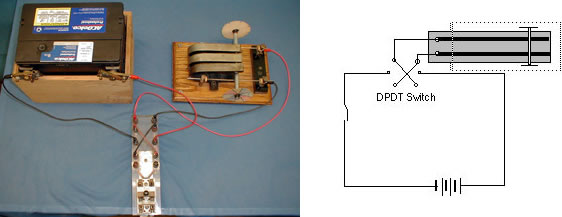Demos: 6B-06 Magnetic Force on a Current-Carrying Conductor

A metal rod, forming the axle of a pair of wheels, is free to roll on pair of parallel metal rails. The rod and rails are part of the electrical circuit shown. The axle sits between the poles of a horseshoe magnet (dotted box in the diagram) so that the magnetic field is into or out of the page. When current is flowing along the axle, it is perpendicular to the field lines, creating a force along the rails, causing the axle to roll. If the current is reversed, the axle rolls in the opposite direction. This illustrates the magnetic force:
Directions: Place the axle carefully on the rails so that it is perpendicular to the rails and near one end of the magnet. Activate the circuit. If the axle tries to roll the wrong direction, reverse the DPDT switch and try again. When the axle has rolled to its maximum extent, reverse the switch and it begin to roll the other way.
Suggestions for Presentation: Describe the set-up carefully, especially showing the various directions of B and i. If a current is flowing perpendicular to the field, in what direction is the force on the conductor?
Applications: Magnetic propulsion systems
Last Updated: Nov 30, 2023 11:25 AM